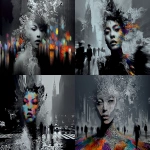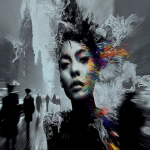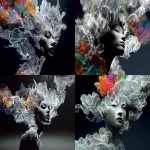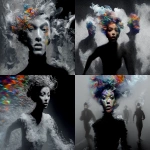Explore the Best AI Image Gallery

The Algorithmic Artist: How AI is Transforming Graphic Design
The world of graphic design is undergoing a radical transformation, driven by the emergence of powerful artificial intelligence (AI) tools. These algorithms are capable of generating stunning visuals, streamlining workflows, and pushing the boundaries of creative expression. But as AI takes on an increasingly prominent role, it raises important questions about its impact on the industry, the nature of creativity itself, and the ethical considerations surrounding its use.
Democratizing Design: AI as a Creative Tool
One of the most significant impacts of AI in graphic design is its ability to democratize the creative process. Traditionally, design skills have been concentrated among a select few professionals. However, AI-powered tools are making it possible for anyone, regardless of their technical expertise, to create professional-quality designs. Platforms like Canva and Adobe Sensei offer user-friendly interfaces that allow individuals to generate logos, marketing materials, social media graphics, and more with just a few clicks.
This accessibility opens up exciting opportunities for small businesses, entrepreneurs, and individuals who may not have had the resources or training to hire a professional designer. It empowers them to create compelling visuals that effectively communicate their brand message and engage their target audience.
Boosting Efficiency and Productivity
Beyond democratization, AI is also revolutionizing design workflows by automating repetitive tasks and streamlining processes. For example, AI algorithms can generate variations of a design concept, helping designers explore different options quickly and efficiently. They can also optimize layouts for readability and visual appeal, freeing up designers to focus on higher-level creative tasks.
AI-powered tools can also automate tasks like resizing images for different platforms, generating captions for social media posts, or even creating personalized marketing materials based on customer data. This increased efficiency allows designers to take on more projects, deliver work faster, and ultimately improve their productivity.
The Ethical Considerations of AI in Design
While the potential benefits of AI in graphic design are undeniable, it is crucial to address the ethical considerations that accompany this technology. One key concern is the potential for job displacement as AI takes over certain tasks currently performed by human designers. It is important to consider how this shift might affect the workforce and explore strategies to reskill and upskill designers for new roles in an AI-driven environment.
Another ethical consideration is the issue of bias in AI algorithms. If AI models are trained on datasets that reflect existing societal biases, they may perpetuate these biases in the designs they generate. It is essential to ensure that AI tools are developed and used responsibly to avoid reinforcing harmful stereotypes or discriminatory practices.
The Future of Design: A Collaborative Partnership
Looking ahead, the future of graphic design likely lies in a collaborative partnership between human designers and AI algorithms. AI will continue to automate tasks, generate creative ideas, and provide valuable insights, while human designers will bring their unique vision, critical thinking skills, and emotional intelligence to the table.
This symbiotic relationship will allow us to harness the power of AI to enhance creativity, efficiency, and innovation in design, ultimately leading to more compelling, impactful, and inclusive visual experiences.
Exploring Emerging Trends
Several exciting trends are shaping the intersection of AI and graphic design:
- Generative Design: AI algorithms can now generate entire designs from scratch based on user-defined parameters or style preferences, pushing the boundaries of creative exploration.
- Personalized Design: AI can analyze customer data to create personalized designs that resonate with individual preferences, leading to more effective marketing campaigns and customer engagement.
- AI-Powered Branding: From logo generation to brand identity development, AI tools are helping businesses create cohesive and impactful brand experiences.
- Interactive Design: AI is enabling the creation of interactive and dynamic designs that respond to user input, providing more immersive and engaging experiences.
Embracing the Algorithmic Artist
The rise of AI in graphic design presents both opportunities and challenges. By embracing these advancements responsibly, designers can leverage AI as a powerful tool to enhance their creativity, streamline workflows, and ultimately deliver even more impactful visual experiences. The future of design is collaborative, where human ingenuity and AI capabilities converge to shape the world around us.


](https://images.ai-img.art/thumbnails/150/a3ed6513a6661aa3ee46e0c2924d1e8888854e91d8908de39db5590dc41f8d8f.webp)



](https://images.ai-img.art/thumbnails/150/0ba0be922ab76af53f75ab90126ae2b18a600ee3b96941e8ab897a9f10594e5a.webp)



















](https://images.ai-img.art/thumbnails/150/bd056a4718c27444e064198762f8dc8ffa1f74f1afd7dcda8d5cb8b142797d6e.webp)



](https://images.ai-img.art/thumbnails/150/ff09e32d2be011c0dd785984c5c1e47839ce551a31da1bde242860b30df2aa30.webp)
